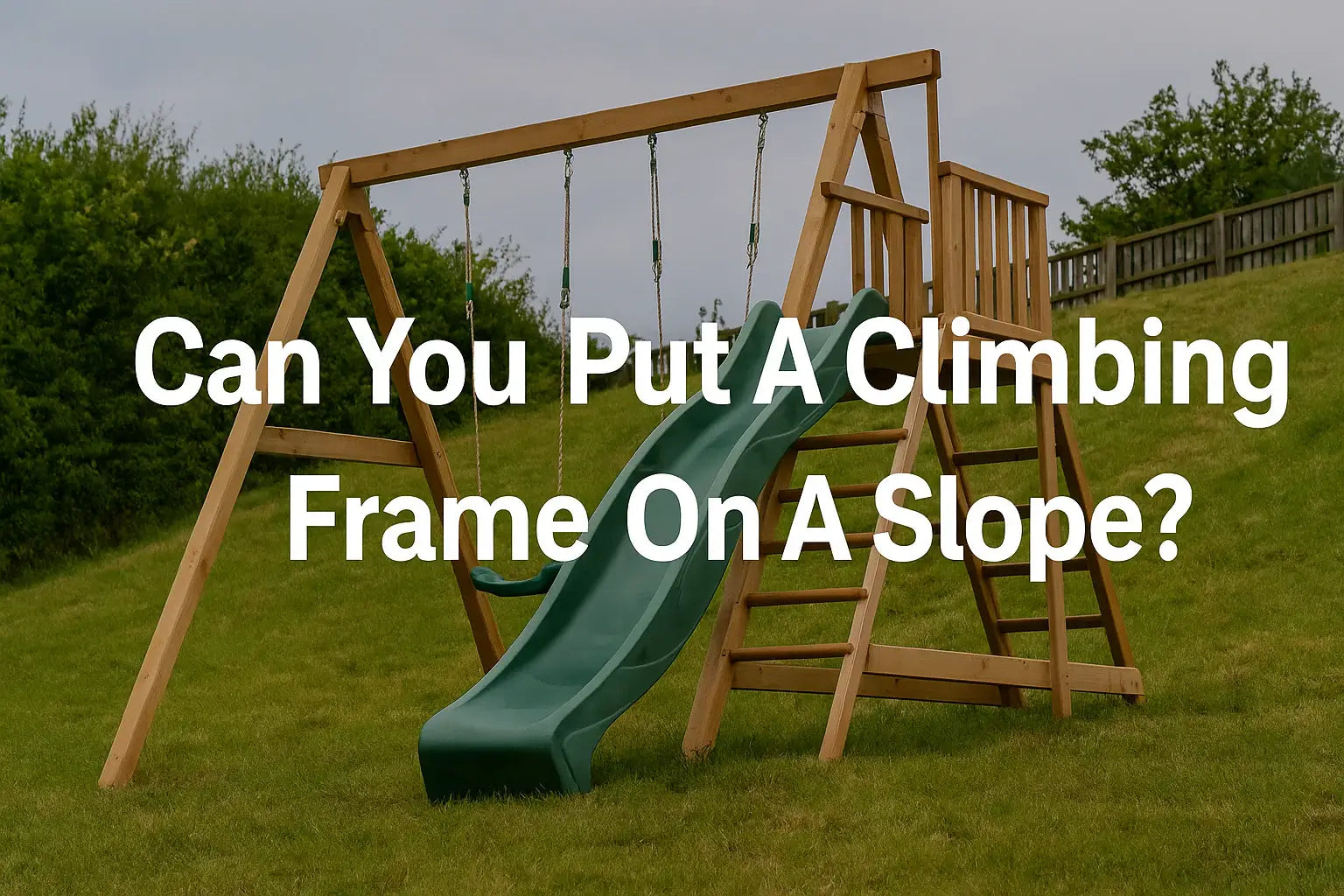
Can You Put A Climbing Frame On A Slope?
Got a wonky garden and wondering if a garden climbing frame is off the cards? Good news: yes, you can put a climbing frame on a slope!
It just takes a bit of prep and planning to get it right. With the right know-how, that sloped patch of grass can become the ultimate play zone — not a hazard.
Stick with us and we’ll show you how to do it safely, securely, and without losing your sanity (or your spade).
The Importance of a Level Surface for Climbing Frame Safety
Why Uneven Ground is a Hazard
Slopes might look harmless, but they can cause more problems than you think — especially when kids are involved.
Risk of Instability and Tipping
Imagine a toddler climbing up a wobbly frame… only for the whole thing to tilt like a seesaw. Not ideal. Climbing frames need a solid, level base to stay put — especially when the play gets energetic.
Uneven Wear and Stress on the Structure
When the legs aren’t sitting evenly, one side takes all the strain. Over time, this weakens bolts, warps wood, and puts pressure where it shouldn’t be.
It’s like sitting on a wonky stool every day — something’s bound to give.
Increased Risk of Falls and Injuries
Kids climb fast, jump high, and rarely stop to think. Uneven ground changes their footing, throws off balance, and increases fall risks. And if the fall zone isn’t level either, bumps and bruises become even more likely.
Manufacturer Guidelines on Level Installation
Before you get out the toolkit, check the manual. Seriously — it matters.
Voiding Warranties with Improper Setup
Most brands clearly state their frames must be installed on flat ground. Ignore that, and if something breaks, you're likely on your own when it comes to repairs or replacements.
Specific Levelling Tolerances
Some climbing frames allow for a slight slope — a few degrees, no more. Adjustable legs might help a little, but always check what’s allowed for your exact model.

Solutions for Installing a Climbing Frame on Sloping Ground
Preparing the Site: Levelling Techniques
Let’s turn that slope into something solid.
Excavation and Cut-and-Fill Method
If your slope isn’t too wild, you can dig into the high side and use the soil to fill in the lower part. This creates a level surface and keeps the natural feel of your garden.
Just make sure the soil is compacted firmly — no one wants a climbing frame sinking after a rainy week.
Building a Retaining Wall or Terraced Area
For steeper gardens, terracing is your best bet. Build up a level platform using timber sleepers, stone blocks, or a small retaining wall.
Think of it like creating a stage for the climbing frame — sturdy, level, and ready for action.
Using Levelling Blocks (with precautions)
If the slope’s minimal, you might get away with levelling blocks or height-adjustable feet. But tread carefully — they’re not a fix for major tilts.
Only use them when you’re sure the frame won’t shift or lean with use.

Anchoring and Stability on a Slope
Even with a levelled surface, the structure still needs anchoring — especially on uneven or soft ground.
Adapting Anchoring Methods for Graded Surfaces
Depending on the slope and soil type, you may need different anchors. Metal ground spikes might not grip enough. Concrete footing? Often the safer bet — especially for bigger frames.
Ensuring All Legs Are Securely Grounded
This is not the time for guesswork. Use a spirit level on each leg. Adjust as needed until all sides are planted firmly and evenly.
Wobbly legs = wobbly play = not worth the risk.
Considering Professional Installation for Slopes
This isn’t everyone’s idea of a weekend project — and that’s OK.
When Expert Help is Recommended
If you’ve got a steep incline, tricky soil, or just want peace of mind, bring in the pros. Landscape installers or playground specialists can sort the groundwork properly.
Benefits of Professional Ground Preparation
Professionals know how to terrace, anchor, and level with long-term safety in mind. And it shows — less settling, more stability, and fewer return visits with a spirit level.

Safety Considerations and Best Practices
Selecting Appropriate Under-Surfacing
Once the frame’s up, don’t skip what goes underneath.
Maintaining Critical Fall Height on Uneven Ground
Even on a slope, you need a safe landing zone. Check fall height recommendations and ensure your ground cover is deep and soft enough — especially on the downslope side where falls may be further.
Types of Surfacing for Sloped Areas
Rubber mulch works well. So does bark or woodchip. Artificial turf? Also great, if installed with a shock-absorbing underlay.
Whatever you pick, make sure it handles the gradient and won’t wash away in a downpour.
Regular Inspections and Maintenance
Time, weather, and active kids all take a toll — especially on sloped installs.
Checking for Shifting or Settling
After heavy rain or frosts, check the base. Has it shifted? Are any legs sinking or pulling free?
Catching it early means quick fixes — not major drama.
Ensuring Continued Stability Over Time
Tighten bolts. Check anchors. Give the frame a firm shake. If anything moves, it needs attention.
Set a reminder to inspect monthly — especially after storms or big playdates.
Have you checked out our other posts?
Can I Put A Climbing Frame In My Garden?
How High Can A Climbing Frame Be?
Can I Put A Climbing Frame On Artificial Grass?
Do Climbing Frames Need Planning Permission?
Can You Put A Climbing Frame On Concrete?
What Is Best To Put Under A Climbing Frame?



Leave a comment